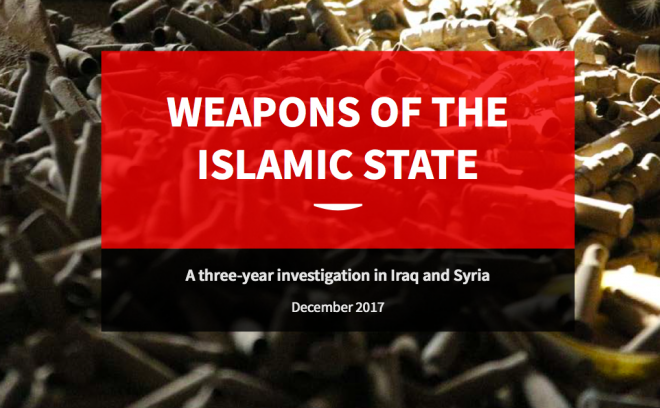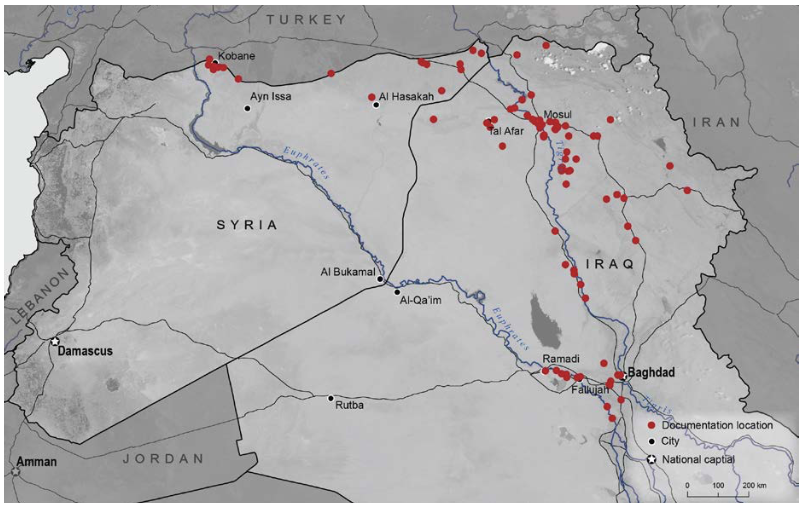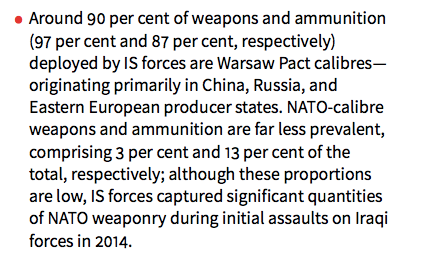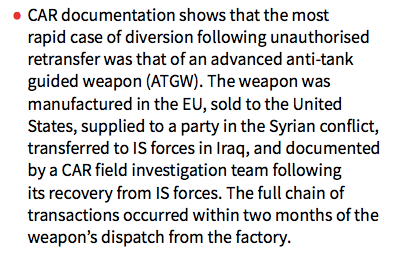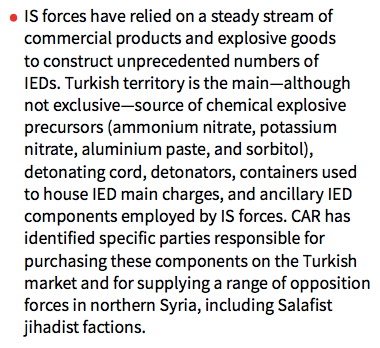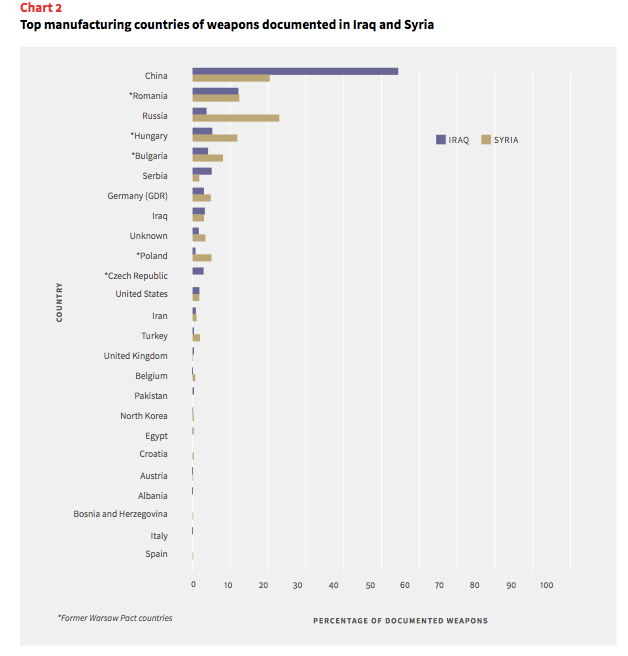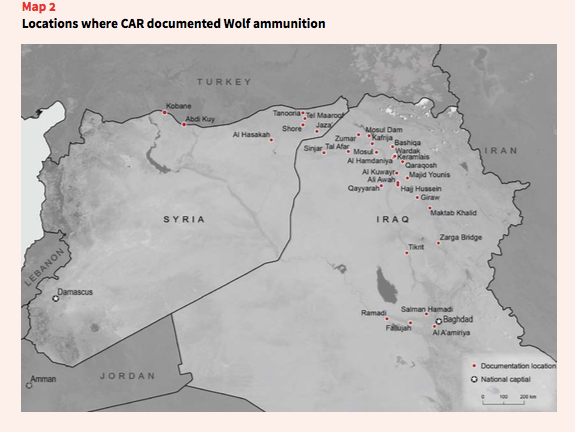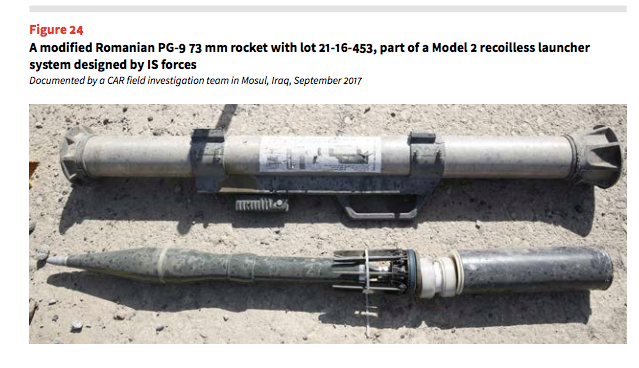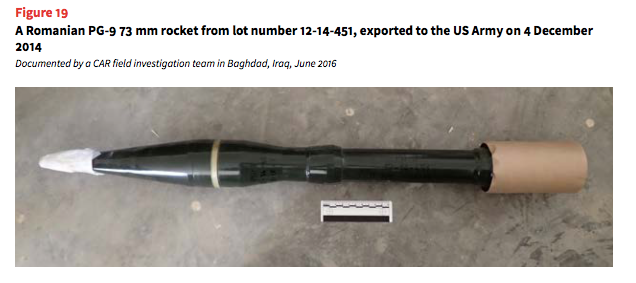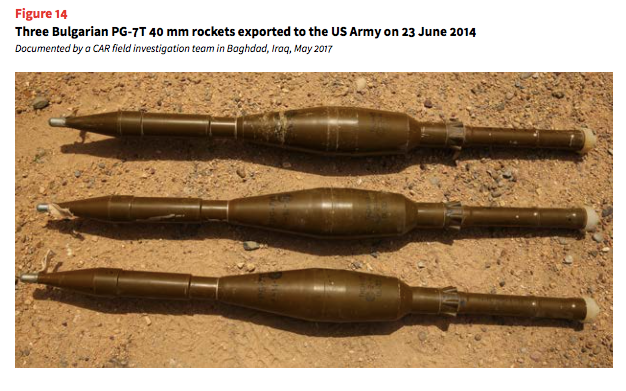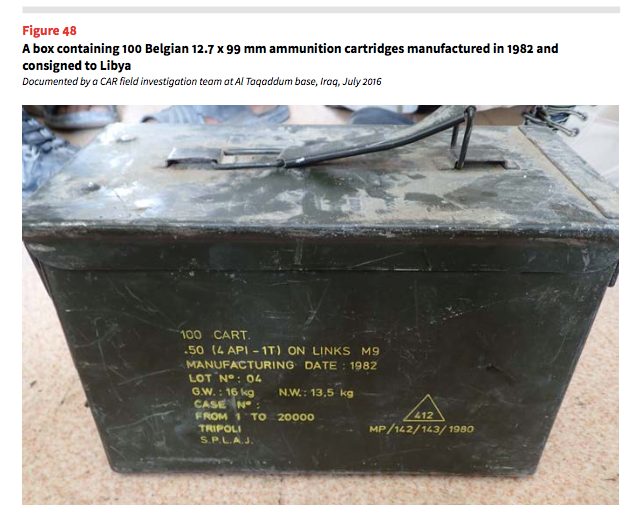Conflict Armament Research has released a report featuring the results of in-person findings of what the so-called Islamic State has been using in the past three years. These findings (40,000 items, 845 small arms) have resulted from personal visits to the frontlines and carefully scrutinizing captured weapons caches. If you can, I would highly recommend reading it yourself over on the organization’s website in the PDF form. We are going to summarize some of the more relevant findings of the report when it comes to small arms use and development here in this essay.
These were Conflict Armament’s conclusive statements on their results-
[so-called Islamic State Forces…]
are in possession of advanced weapon systems, which will pose a threat to regional and international forces in the years to come;
have a demonstrated ability to manufacture improvised weapons and IEDs on a large and sophisticated scale; and
are able to tap into regional and international commercial markets to acquire chemical precursors and off-the-shelf products for the development of ‘new’ weapons.
One very important note on Conflict Armament is that the organization believes very strongly in primary source investigation. Almost every small arm or device reported on by Conflict Armament has been physically examined, photographed, and even disassembled by one of their own researchers in-country. Whether that is in Iraq, Syria, or even the Sudan, these researchers go with armed escorts to conduct their work. As an example of their methodology, a photograph of an FS200 being sold on the Libyan black market isn’t enough for CAR, it must be physically in front of a researcher for the serial number to be recorded and reported on.
Of course, although this has much merit in how concrete the research is, there are two points that I have to make before we continue to evaluate the organization’s report. The first is that every data point inside of it are only the items that CAR has gotten their hands on. There are perhaps hundreds of small arms per single small arm that CAR reported on, that aren’t included in the findings. Is this picture of so-called Islamic State weaponry skewed? Perhaps, yes. However, of everything that CAR laid their hands on, the data is most likely very accurate, if not completely so due to their methodology. For a good example, CAR reported on a large number of Chinese 7.62x39mm Type 81 LMGs that were seized from IS.
At TFB and even over at ARES, there has been extremely limited reporting of the Type 81 LMG in combat by IS. We would have jumped on that sort of knowledge. CAR has established that IS was/is using the Type 81 beyond the shadow of a doubt, but from a tactical perspective or even a logistical ones, it is possible that the Iraqi Army just so happened to overrun the so-called Islamic State’s one warehouse that contained Type 81s.
Secondly, we must keep in mind that because Conflict Armament has to work hand in hand with the local governments and armed groups, we cannot ignore the possibility that these state or non-state actors are allowing Conflict Armament to see what they allow them to see. We might not be seeing some of the more controversial or exciting findings because they were put into active use, the Iraqi government used them to arm PMU units, or perhaps another international intelligence organization got to the arms before Conflict Armament did. This is precisely the reason why the Pattern Room in the United Kingdom has existed for so long, because of the need for technical intelligence.
Relevant Findings
One of the conclusions that CAR has come up with is that the overwhelming majority of the small arms and ammunition recovered were of Warsaw Pact countries in origin. How much of it was already in the region when so-called Islamic State gathered momentum in 2014, and how much came into the region afterward should be a question that we will continue to research. When it comes to manufacturing dates, CAR had this to say, “Weapons manufactured in the current decade (2010–17) comprise less than 2 percent of the group’s total weapon holdings, while more than 60 percent were manufactured before 1990. In marked contrast, more than 15 percent of the group’s ammunition dates from the 2010–17 period”. Another statistic mentioned that over 40 percent of the rockets manufactured after 2010 were from EU member countries. Some of these EU origin weapons were actually initially sold to U.S. companies and then supplyed to Syrian opposition.
But of the material that did come after 2014, CAR had an astonishing find that a number of pieces (mostly anti-armor weapons) that came within just weeks of being produced in Europe or the United States, and then finding a way into IS hands.
Where do the IED and HME components come from? CAR points to a majority flowing through Turkey. This is a very tricky issue to tackle because fertilizer or alarm clock components aren’t weapons in of themselves. How can you prove in a court of law that a Turkish businessman selling hundreds of alarm clocks to someone in Turkey, is inadvertently supporting international terrorism?
Many analysts theorized that IS was using a large number of U.S. supplied material that had been captured during the capture of Mosul. CAR’s evidence suggests that these small arms might have played a larger role in propaganda purposes, rather than any battlefield use-
CAR’s data on recovered IS weapons appears to contradict the narrative that IS forces deployed a significant quantity of US-made rifles chambered for NATO calibres, which the group reportedly captured in the 2014 o ensives that led to the capture of Mosul. IS forces have perpetuated this narrative in their propaganda—o en featuring US-made weapons in online images and videos
As mentioned earlier, this is one of the more interesting finds when it comes to specific types of small arms documented. We often see the Type 81 outside of China as a sort of export weapon that Norinco markets to Chinese allies, while never in much wide-spread use by Chinese PLA troops. Even more interestingly, CAR documented more Russian origin ammunition captured in Iraq (almost 30 percent), whereas the overwhelming majority of captured ammunition in Syria was Chinese in origin (almost 50 percent) (Charts 7,8, page 20). 
There was also a Chinese 5.56x45mm CQ rifle recovered at Kobane (page 41), yet another example of a Chinese export small arm. (page 64)
Russian and Ukranian steel cased Wolf ammunition was extremely prevalent in the investigation. Much of this originating from contracts to supply the Iraqi Armed Forces and even Afghan forces with subcontracts of ammunition that went to Iraq (Page 35).
At least three factories have manufactured Wolf ammunition, including the Barnaul Cartridge Plant (Russia), Tula Cartridge Works (Russia), and Lugansk Cartridge Works (Ukraine). Sporting Supplies International initially marketed this ammunition on the civilian market in the United States. Wolf ammunition from all three factories is also in service with military and non-state forces in Afghanistan, Iraq, and, to a lesser extent, parts of sub-Saharan Africa. Cartridges manufactured by the various factories di er in bullet and headstamp design, and weight. Since July 2014, CAR has repeatedly documented Wolf ammunition and packaging for both military and commercial sales, in 7.62 x 39 mm and 7.62 x 54R mm calibres, throughout Iraq and Syria (see Map 2). Russian factories manufactured the lots CAR documented, which date from 2007, 2008, and 2010.
U.S. entities that took part in arming either the covert CIA lead operation to arm rebel groups within Syria, or were simply contracted out to supply various purchase orders for Iraqi or Afghan forces were also listed in detail. The European supply entities were probably much harder to gain access to and we don’t see many listings of them by CAR. We’ve already seen some of this on TFB with reporting on the Azeri Silk Way Airlines, essentially being a vehicle to move covert arms and ammunition all over the world in the diplomatic pouch at times. An interesting point that CAR made was that Amman, Jordan appeared to have been a popular airport for some of these exports to make their way into Syria, from Europe (page 72).
CAR also had documented evidence of the locally made rocket launchers that IS had been using as well (page 45). We reported on these through TFB in May of last year. Because rockets are slightly easier to trace due to their more stringent export requirements and the fact that they are usually well serialized, there was a very substantial portion of the investigative report dedicated to them.
This chart shows how serial numbers on M93 rockets were corroborated, and how it wasn’t just individual rockets coming through to Syria, but instead entire batches directly from the factory, especially evident in Series 1. (page 59)
Libyan and Saudi connection
Although relatively far from Syria, there appears to have been a Libyan supply connection of arms transfers that included large amounts of previously exported Belgian ammunition to Muammar Gaddafi in the 1980s (page 60). Recent Saudi transfers of previously purchased Bulgarian material was also found (page 57).
Other non-European countries where material showed up from included Pakistan, Sudan, China, Afghanistan, Azerbaijan, Turkey, and of course, Iran.
 Your Privacy Choices
Your Privacy Choices
